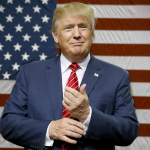Donald Trump’s presidency will undoubtedly have a lasting effect on the shape of the Supreme Court.
Since 1789, there have been 112 justices on the Supreme Court. Having the opportunity to appoint a new justice is one of the prize opportunities for a president. With the right young justice, a president can influence American law and society for decades to come. For instance, Anthony Kennedy, the current “swing justice” on the Court, was appointed by President Reagan. Since he sits in the ideological middle of this current court, Kennedy’s views on the law often determine how American justice works. And for that, we owe thanks to a president who was last elected 32 years ago and has been dead since 2004. That’s the power of a Supreme Court appointment.

David S. Cohen, Rolling Stone, Grand Theft Judiciary: How Republicans Stole the Supreme Court, available at: http://www.rollingstone.com/politics/features/how-trump-and-the-republicans-stole-the-supreme-court-w450269.
When Justice Scalia died earlier this year, President Obama was given the opportunity to fill his third seat on the Court. He had previously replaced David Souter with Sonia Sotomayor and John Paul Stevens with Elena Kagan. Congressional Republicans refused to schedule a hearing for Obama’s latest nominee – Merrick Garland – in what looks to be a seismic political victory for the GOP. An Obama replacement would have given the Court its fifth liberal justice and shifted balance to the political left in historically significant ways.
With a President Trump nominee looming in the near future, how will the Court be reshaped? And how many more seats may open in the years ahead?
Mr. Trump’s previously-released candidate list, which has since been removed from his campaign’s website, included 21 potential nominees. The candidates are described by Court watchers as pro-life; conservative in bent; and advocates for the Second Amendment. The candidates are:
•Justice Don Willett, Texas Supreme Court
• Judge William H. Pryor Jr., Eleventh Circuit
• Judge Neil M. Gorsuch, Tenth Circuit
• Judge Diane S. Sykes, Seventh Circuit
• Judge Margaret A. Ryan, U.S. COA for the Armed Forces
• Justice Edward Mansfield, Iowa Supreme Court
• Justice Keith R. Blackwell, Ga. Supreme Court
• Justice Charles T. Canady, Fla. Supreme Court
• Chief Judge Timothy M. Tymkovich, Tenth Circuit
• Judge Amul R. Thapar, E.D. Ky.
• Judge Federico A. Moreno, S.D. Fla.
• Chief Justice Robert P. Young Jr., Mich. Supreme Court
• Judge Steven Colloton, Eighth Circuit
• Justice Allison H. Eid, Colo. Supreme Court
• Judge Thomas M. Hardiman, Third Circuit
• Judge Raymond M. Kethledge, Sixth Circuit
• Justice Joan L. Larsen, Mich. Supreme Court
• Justice Thomas R. Lee, Utah Supreme Court
• Judge Raymond W. Gruender, Eighth Circuit
• Justice David R. Stras, Minn. Supreme Court
• Sen. Mike Lee (R-Utah)
Mr. Trump has explicitly said that he wants to overturn Roe v. Wade and criticized the Court’s decisions on same-sex marriage.
If Donald Trump is able to replace not only Justice Scalia, but also one of the more liberal leaning Justices then many areas of constitutional law may be transformed. The two most obvious would be the jurisprudence surrounding abortion and affirmative action. Two picks to the Supreme Court might be sufficient to overturn Roe v. Wade, and therefore a woman’s right to choose to have an abortion. Another case, Grutter v. Bollinger, which upheld some types of affirmative action in university admissions, could also be overturned. Beyond that, we also might expect several areas of law dealing with federal power to change. For example, the Supreme Court’s decision upholding the Affordable Care Act was a five to four vote, that might have gone the other way if one of Trump’s picks had sat in the seat of one of the more liberal Justices. The same might be said for marriage equality – Obergefell v. Hodges was another 5-4 decision – that likely would have gone the other way.
Post-Election Q&A: Stanford Law School Faculty Weigh-In on the Election of Donald Trump, Nov. 11, 2016, available at: https://law.stanford.edu/2016/11/11/post-election-qa-stanford-law-school-faculty-weigh-in-on-the-election-of-donald-trump/.
As of now, there is no sign that any of the current Justices would leave the Court in the next few years, health notwithstanding. Justice Ginsburg is the oldest, at age 83; Justice Kennedy will be 80 in July; and Justice Breyer will be 78 years old in August.
According to exit polling done during the 2016 election, the Supreme Court was an important factor for many voters. The President-elect’s supporters hope he does not disappoint.